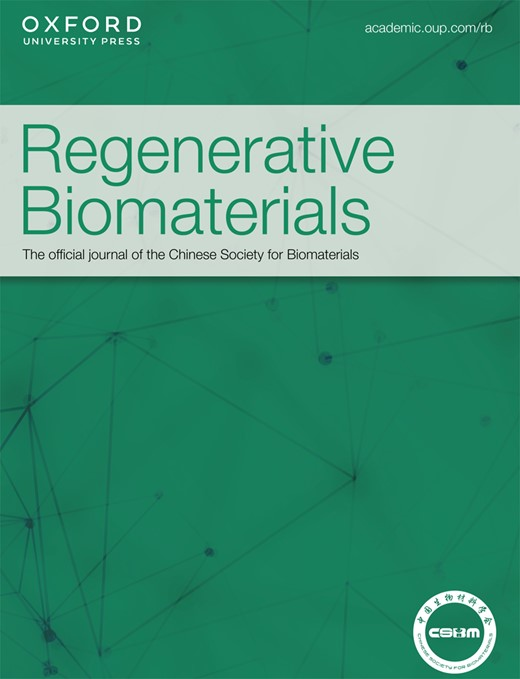Antibacterial and antioxidant bifunctional hydrogel based on hyaluronic acid complex MoS2-dithiothreitol nanozyme for treatment of infected wounds
IF 5.6
1区 医学
Q1 MATERIALS SCIENCE, BIOMATERIALS
引用次数: 0
Abstract
Wound repair is a complex physiological process that often leads to bacterial infections, which significantly threaten human health. Therefore, developing wound-healing materials that promote healing and prevent bacterial infections is crucial. In this study, the coordination interaction between sulfhydryl groups on dithiothreitol (DTT) and MoS2 nanosheets is investigated to synthesize a MoS2-DTT nanozyme with photothermal properties and an improved free-radical scavenging ability. Double-bond-modified hyaluronic acid is used as a monomer and is cross-linked with a PF127-DA agent. PHMoD is prepared in coordination with MoS2-dithiothreitol as the functional component. This hydrogel exhibits antioxidant and antibacterial properties, attributed to the catalytic activity of catalase-like enzymes and photothermal effects. Under the NIR, it exhibits potent antibacterial effects against gram-positive (Staphylococcus aureus) and gram-negative bacteria (Escherichia coli), achieving bactericidal rates of 99.76% and 99.42%, respectively. Furthermore, the hydrogel exhibits remarkable ROS scavenging and antioxidant capabilities, effectively countering oxidative stress in L929 cells. Remarkably, in an animal model, wounds treated with the PHMoD(2.0) and NIR laser heal the fastest, sealing completely within 10 d. These results indicate the unique biocompatibility and bifunctionality of the PHMoD, which make it a promising material for wound-healing applications.基于透明质酸复合物 MoS2-二硫苏糖醇纳米酶的抗菌抗氧化双功能水凝胶用于治疗感染性伤口
伤口修复是一个复杂的生理过程,往往会导致细菌感染,严重威胁人类健康。因此,开发既能促进伤口愈合又能防止细菌感染的伤口愈合材料至关重要。本研究通过研究二硫苏糖醇(DTT)上的巯基与 MoS2 纳米片之间的配位相互作用,合成了一种具有光热特性和更强自由基清除能力的 MoS2-DTT 纳米酶。以双键修饰的透明质酸为单体,并与 PF127-DA 药剂交联。PHMoD 是以 MoS2-二硫苏糖醇为功能成分配位制备的。这种水凝胶具有抗氧化和抗菌特性,这归功于类似催化酶的催化活性和光热效应。在近红外条件下,它对革兰氏阳性菌(金黄色葡萄球菌)和革兰氏阴性菌(大肠杆菌)具有很强的抗菌效果,杀菌率分别达到 99.76% 和 99.42%。此外,水凝胶还具有显著的清除 ROS 和抗氧化能力,能有效对抗 L929 细胞中的氧化应激。值得注意的是,在动物模型中,使用 PHMoD(2.0) 和近红外激光治疗的伤口愈合最快,可在 10 d 内完全愈合。
本文章由计算机程序翻译,如有差异,请以英文原文为准。
求助全文
约1分钟内获得全文
求助全文
来源期刊

Regenerative Biomaterials
Materials Science-Biomaterials
CiteScore
7.90
自引率
16.40%
发文量
92
审稿时长
10 weeks
期刊介绍:
Regenerative Biomaterials is an international, interdisciplinary, peer-reviewed journal publishing the latest advances in biomaterials and regenerative medicine. The journal provides a forum for the publication of original research papers, reviews, clinical case reports, and commentaries on the topics relevant to the development of advanced regenerative biomaterials concerning novel regenerative technologies and therapeutic approaches for the regeneration and repair of damaged tissues and organs. The interactions of biomaterials with cells and tissue, especially with stem cells, will be of particular focus.
 求助内容:
求助内容: 应助结果提醒方式:
应助结果提醒方式:


